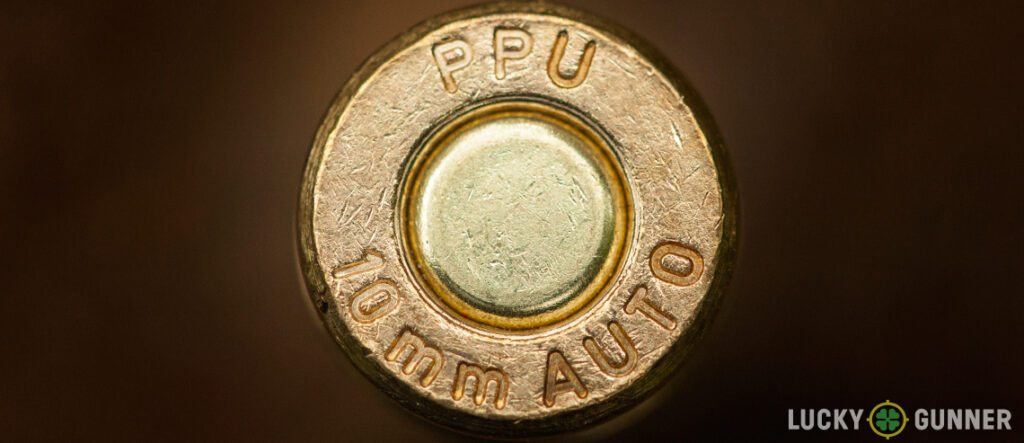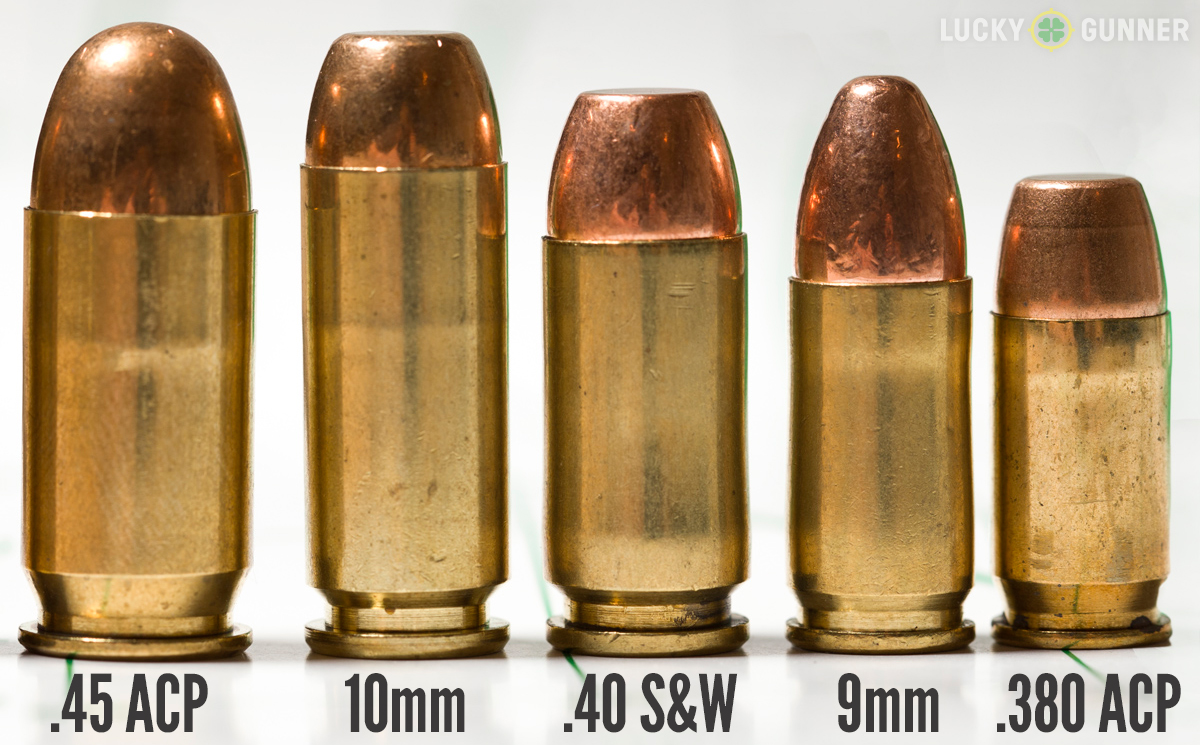Editor’s Note: The following post comes from Mike Branson, the newest contributor to the Lucky Gunner Lounge writing team. Mike has been shooting, working on, and writing stuff about guns for a long time, and we’re excited to have his experience on board. Along with Melody and Jim, and Kyle, Mike is helping me out with the writing duties here so I can work on some other big projects you’ll be hearing more about in the very near future. So stay tuned and in the meantime, be nice to Mike and the other guys.
-CB
I’ll admit it up front. I didn’t think the 10mm was going to make it. Unusual calibers that fill niche roles, like 5.7x28mm and .38 Super, tend to have a small but vocal cadre of fans who insist the caliber is totally awesome and underrated. I get that. It’s part of what makes the shooting hobby fun. 10mm fit into that category for most of my shooting life. It always seemed to be barely holding on, just one or two more years away from falling into the Sargasso Sea of Dead Calibers. I always thought it would eventually fade away, remembered only by a few pistol hunters and Colt Delta Elite collectors. I was wrong. The 10mm is resurgent. It’s the comeback kid. How? Why?
10mm: The Early Years
It’s fair to say that if the 1986 Miami Shootout hadn’t happened, you and I might not know about 10mm at all. If you haven’t ever read about the incident, it was an ugly deal. Five FBI agents were gravely wounded and two, Jerry Dove and Ben Grogan, were killed. The dirtbag who did all this damage was hit 12 times before he expired. In the aftermath, the FBI decided their 9mm and .38 Special ammo had let them down. A whompin’ stompin’ upgrade in handgun power would keep another Miami Shootout from ever happening again.
In the 1980s, 10mm was an up and coming new cartridge. Sonny Crocket was dealing hot lead with his exotic Bren Ten on this week’s episode of Miami Vice, and Colt’s exotic Delta Elite was available to 1911 shooters that wanted a power boost over .45acp.
In 1990, with its adoption by the FBI, 10mm would finally take its rightful place in the pantheon of great handgun calibers. Heckler & Koch was even making the Mp5 in 10mm. Surely the 1990s would see its widespread adoption by law enforcement agencies throughout the country and thousands of recreational shooters, right?
Nope. The 10mm house of cards collapsed quickly. Everything that could go wrong did go wrong. The Smith & Wesson 1076 pistols adopted by the FBI experienced parts breakages during routine training and qualifying. The metallurgy of the time period couldn’t hold up against high round counts in that caliber. The other thing breaking was the spirit of the agents shooting the guns. It was a race to see what would give out first, the big all-stainless sidearm or the wrist of the shooter.
The FBI originally ordered 10,000 pistols from Smith and Wesson but accepted only 2,400 before cancelling the contract outright. Agents that didn’t like the big Smith opted to carry Sig 228s in 9mm, while the agency hastily passed out a less potent 10mm “FBI load”. On the civilian end, Colt stopped making the Delta Elite in 1996 due to sluggish sales. Law enforcement agencies all over the country rushed to adopt the .40S&W, which was basically the “FBI load” stuffed into a shorter casing that would fit into double stack 9mm frames like the Browning Hi Power, Beretta 92 and the new, amazing, world-beating Glock 22. 10mm was yesterday’s news, debunked.
There were some good reasons for the collapse. The original loading called for a 200 grain bullet traveling at 1200 feet per second, yielding roughly 640 foot pounds of muzzle energy. By comparison, your typical Winchester White Box .45 ACP round lists at 356 foot pounds. Roughly 1.5 times the kinetic energy of .45 ACP going in one direction means a lot of recoil going in the other direction. As the FBI discovered, this is hard on both guns and wrists.
One of my buddies has two original Delta Elites that are retired after shooting full-spec ammo for roughly a thousand rounds each. The frame and slide rails have galled against each other, the barrel bushings are toast. When my only choices for a caliber are used guns that don’t last very long if I actually shoot them, I’m picking something else. By the late 90’s that’s what most shooters did. A few diehard 10mm fans were enough to keep Glock producing its excellent model 20, but, in general, the 10mm languished, not dead, but asleep.
10mm at the Range
Shooting the 10mm is an intense experience, like shooting a Magnum revolver. Unlike a .45 ACP that gives the hands a strong but smooth shove, the 10mm gives you all its recoil at once, in a sharper, more insistent slap against the hands. The “grin per shot” factor is very high at the range. Lots of curious folks will ask to shoot two or three shots, grin from ear to ear, and that’s enough for them. Few shooters will bring a 10mm to a serious training class of 500 rounds or more. My friends who shoot 10mm regularly say they appreciate how the round drops bowling pins and steel plates with authority, and they don’t mind the challenge posed by the stout recoil. Its not for everyone, but fortunately, you aren’t forced to shoot the hot stuff in this caliber if you don’t want to.
In the same way that we often shoot .38 Special rounds through our .357 Magnum chambered revolvers, the “FBI load” with ballistics and recoil close to .40S&W is actually the easier loading to find. Many 10mm shooters I’ve talked to say they shoot the “FBI load” recreationally, and practice just enough with their favorite hot loading to stay proficient with it for concealed carry or hunting. The full house, hot load 10mm’s stopping power in these applications, when every round counts, is drawing experienced shooters to it again.
See, the 10mm wasn’t a bad idea, it was just ahead of its time.
A Second Wind
Time is catching up with 10mm and a variety of factors, some good and some bad, are all contributing to increase its popularity again. The tremendous advances in metallurgy and CNC manufacturing mean that pistols built today can handle the power of 10mm much better than their 1980s counterparts. The Rock Island Armory 1911 pictured above has more than 1000 rounds through it and has held up much better than my buddy’s old Delta Elites did with the same round count. Unlike the classic Colts, it has a fully ramped bull barrel and full length guide rod, features that were exotic and experimental in 1986 but don’t even raise an eyebrow now. There’s no sign of galling between the frame and slide, no peening, no cracks, no nasty burrs forming on the locking lugs or the recoil lug under the barrel. It’s still using the original extractor and it runs like a champ.
Am I saying a new production Rock Island Armory gun is made better than a real Colt from 30 years ago? Well gee, it just might be. Colt hasn’t been resting on their laurels either. The new Delta Elites incorporate improvements to prevent frame cracking and other fitment issues. CNC machining is why we now have tiny 9mm pocket pistols that last longer than bigger .380 pistols used to. Manufacturing technology has improved tremendously in just the past ten years. Companies no longer look at 10mm and think “if we make this, we’ll just get a bunch of broken guns returned to us for warranty work.”
On the bad side, another factor conspiring to bring back 10mm, .357 Sig, and other less popular caliber choices is ammo cost. 10mm used to scare off many shooters because it was so expensive compared to .45acp, 9mm, and .40 S&W. Well these days, it’s all gotten more expensive. The days of blasting through half a case of ammo on Saturday just for the heck of it are long gone for most of us. If its all going to be expensive to shoot, why not pick your caliber based on its ballistic merits instead of its price point?
So if 10mm is coming back, who is making 10mm pistols these days? There’s Colt, which released an improved Delta Elite about five years ago. Kimber, Dan Wesson, and, most recently, Rock Island Armory are giving 1911 shooters more 10mm options. EAA’s Witness series currently lists no less than 13 variants chambered in 10mm. At the 2015 SHOT Show, Glock announced the Glock 40, a long slide 10mm pre-cut for a slide mounted optic, joining their successful 20 and 29 models.
Sig Sauer announced at the same SHOT Show that they are chambering their iconic P220 in 10mm for the first time ever. VLTOR Weapons Systems has an ongoing project to re-engineer the original Bren Ten for the 21st century, but so far they haven’t been able to mass produce a gun that meets their standards. They are hoping for a 2016 release.
What I’m waiting for is more carbines chambered in 10mm. DJ Getz makes an excellent clone of the old FBI Mp5/10, and the longer carbine barrel boosts the bullet’s velocity even further, while keeping recoil more manageable than any pistol could. Its a win-win. Why not a 10mm Sig MPX? Or a 10mm CZ Scorpion EVO? Seems like a no-brainer to me.
10mm Auto doesn’t pretend to be all things to all people. Its a hard hitting caliber that offers great muzzle energy and excellent penetration at the cost of recoil and, perhaps, durability and longevity of the guns in its caliber. Friends of mine who shoot 10mm told me great anecdotes about its real world stopping power, like a friend who dropped a deer at 80 yards with his Glock 20 using an extended 6 inch barrel. Another friend has used it repeatedly to fend off those pestilential feral hogs in Texas.
Most of my friends consider the round to be “overkill” for concealed carry, with one exception. I have one buddy who carries a Glock 29 and chose the 10mm specifically for its penetration advantage. He considers the caliber fairly barrier-blind for a pistol round, and told me “bad guys tend to hide behind stuff while they shoot at you.” On the other hand, I asked him what training with the Glock 29 was like and he texted me back a one-word reply: “Abusive!”
10mm is making its comeback among shooters who don’t mind absorbing a little abuse on their end in exchange for more impact on the other end. Are you one of them? Think the 10mm comeback is just a fad? Why?


